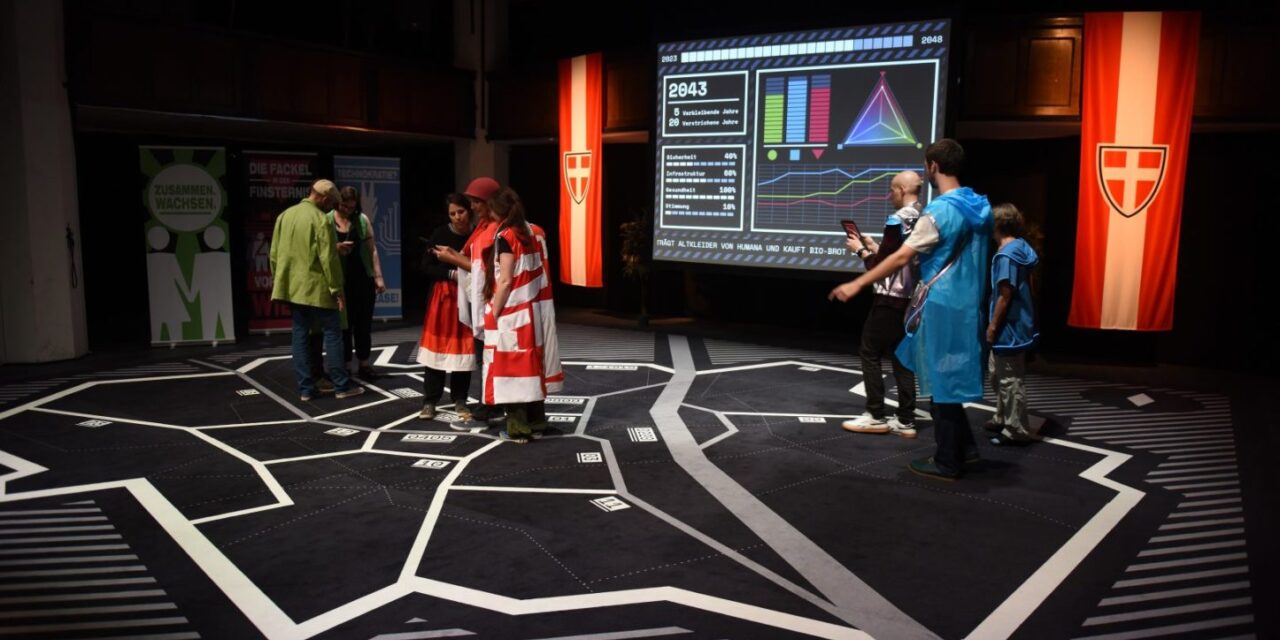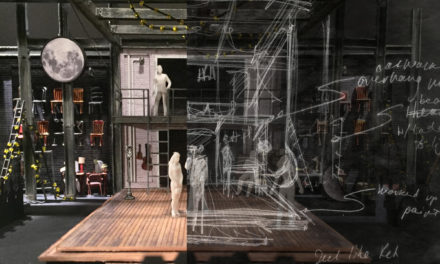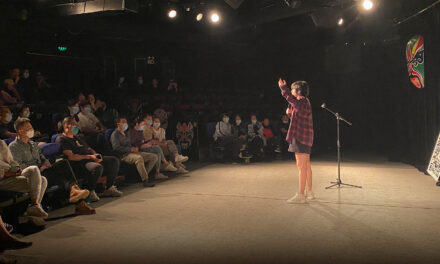Georg Hobmeier is an artist and narrative game designer who is working in several fields: game design, theatre, but he is also organizing other game-related events as well. Hobmeier was one of the special guests of Zip-Scene Conference vol. 2. On this occasion, we asked him to tell us a bit more about his practice and how is to be a narrative game designer in Central Europe.
A.B: What is your background? And how do you define your profession nowadays?
George Hobmeier: I started playing A LOT of TTRPGs, when I was a child, segwayed into theatre via Shakespeare’s Midsummernight’s Dream (common denominator: elves), got really, really bored by the German theatre world and their old fashioned hierarchies, moved on to choreography and devising theatre, got annoyed that everything was still controlled by a handful of dudes/”curators” and somehow ended up making computer games due to a serious of incidents.
These days, I call myself a narrative game designer.
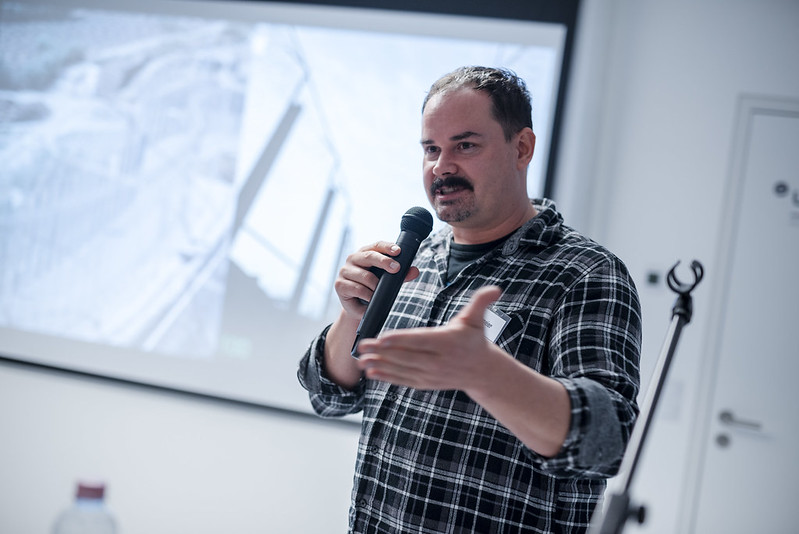
Georg Hobmeier presenting at Zip-Scene Conference in November 2019. Photo: Máté Lakos
A.B: I was a participant in your production Vienna – All Tomorrows. It gave me some shivers not only about depicted possibilities but also what kind of participation possibilities do I have – as a citizen. How did you develop it? Was it important for you to be presented in a theatre and not in another environment?
G.H: The project itself was conceived by request of the Viennese Volkstheater, let’s call it a commission, yet the design was based on numerous influencing factors, games that we played and liked, scenarios we were working on in other projects and a particular well-working mix of people that came together in this undertaking.
The presence in the theatre happened because they produced it. It might as well have been a standalone escape room style setting. But of course, plenty of advantages came with the theatre as a partner: an archive of adoptable props, a modest budget, specialists + tech from the house we could use.
A.B: Do you think that the new media artworks that are using game mechanics to engage their audience is the future of media arts or is it just a trend? Will we get over the “immersive” buzzword?
G.H: I heard immersion already back in the 1990s and it meant next to nothing back then already so it’s on my ignore list together with words like innovation, excellence, and others.
Truth told I know so little of the new media art “market” these days that I have no idea what game mechanics they are using. I have immersed myself in the world of games over the last half a decade, so I could only speak from that perspective. Let’s put it that way: immersive entertainment is growing quite a bit and there is an increasing overlap with art, as far as I can perceive it. It’s an exciting thing to do, this kind of design for both audience and creators, it might well be here to stay.
A.B: In your work, you often dealing with societal issues. What is your methodology to develop these?
G.H: Read political news, articles, and books, all day long. Sometimes, I’m even right, when debating things on Twitter.
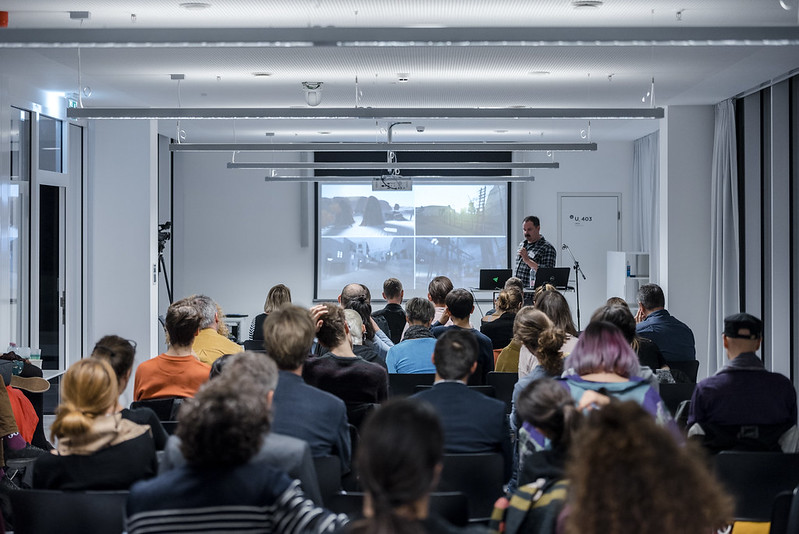
Hobmeier at Zip-Scene. Photo: Máté Lakos.
A.B: How can new media and participative works reach out for a really new audience type? And how can they initiate a slow change in mindset?
G.H: That is a tricky question. Outreach is hard. Sometimes, theatres think, “Oooh, we’re making this exciting new work, let’s post it on Facebook, thousands of young people will come.” It doesn’t work like that, but with the right mix of new work and new channels, one might slowly get new faces in the participating audience. In Austria, this is quite tricky. Art crowd is elitist to the hilt, theatre audiences are 50+. Compared to other countries, we bask too much in the glory of the past. That’s why I decided to settle in commercial forms until now.
A.B: What are the situations of new media/art and serious game professionals in Austria? Is their number growing? And are there funds that are supporting their work, or they have to find alternative sustainability strategies? (for example, Cause Creations – how do you “function”?)
G.H: We are a tiny, tiny group here. There are a handful of serious games companies, growing only in the sense that there used to be two and now there are four. We are by far the most “artistic” ones. There is a big divide between commercial work and artwork, which is also structural. I can’t access creative industry grants as an artist and I can’t access art grants as a company. So we have to dance a weird tango with numerous overlapping entities. Causa Creations is now shifting that a bit. We are looking now more at bigger partners and change our focus on the framework for a series of projects instead of standalone projects. Also, a lot of work-for-hire, which is more fun than I thought and a welcomed source of income.
This article was originally posted at zip-scene.com on December 30th, 2019, and has been reposted with permission. To read the original article, click here.
This post was written by the author in their personal capacity.The opinions expressed in this article are the author’s own and do not reflect the view of The Theatre Times, their staff or collaborators.
This post was written by Ágnes Bakk.
The views expressed here belong to the author and do not necessarily reflect our views and opinions.

